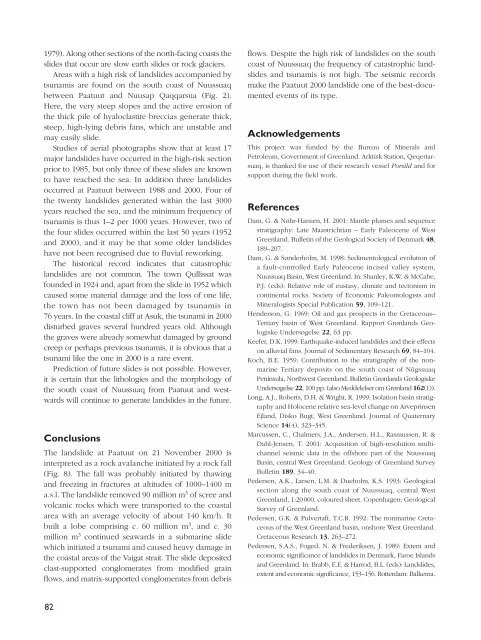Review of Greenland Avtivities 2001 - Tsunami-generating ... - GEUS
Review of Greenland Avtivities 2001 - Tsunami-generating ... - GEUS
Review of Greenland Avtivities 2001 - Tsunami-generating ... - GEUS
You also want an ePaper? Increase the reach of your titles
YUMPU automatically turns print PDFs into web optimized ePapers that Google loves.
1979). Along other sections <strong>of</strong> the north-facing coasts the<br />
slides that occur are slow earth slides or rock glaciers.<br />
Areas with a high risk <strong>of</strong> landslides accompanied by<br />
tsunamis are found on the south coast <strong>of</strong> Nuussuaq<br />
between Paatuut and Nuusap Qaqqarsua (Fig. 2).<br />
Here, the very steep slopes and the active erosion <strong>of</strong><br />
the thick pile <strong>of</strong> hyaloclastite breccias generate thick,<br />
steep, high-lying debris fans, which are unstable and<br />
may easily slide.<br />
Studies <strong>of</strong> aerial photographs show that at least 17<br />
major landslides have occurred in the high-risk section<br />
prior to 1985, but only three <strong>of</strong> these slides are known<br />
to have reached the sea. In addition three landslides<br />
occurred at Paatuut between 1988 and 2000. Four <strong>of</strong><br />
the twenty landslides generated within the last 3000<br />
years reached the sea, and the minimum frequency <strong>of</strong><br />
tsunamis is thus 1–2 per 1000 years. However, two <strong>of</strong><br />
the four slides occurred within the last 50 years (1952<br />
and 2000), and it may be that some older landslides<br />
have not been recognised due to fluvial reworking.<br />
The historical record indicates that catastrophic<br />
landslides are not common. The town Qullissat was<br />
founded in 1924 and, apart from the slide in 1952 which<br />
caused some material damage and the loss <strong>of</strong> one life,<br />
the town has not been damaged by tsunamis in<br />
76 years. In the coastal cliff at Asuk, the tsunami in 2000<br />
disturbed graves several hundred years old. Although<br />
the graves were already somewhat damaged by ground<br />
creep or perhaps previous tsunamis, it is obvious that a<br />
tsunami like the one in 2000 is a rare event.<br />
Prediction <strong>of</strong> future slides is not possible. However,<br />
it is certain that the lithologies and the morphology <strong>of</strong><br />
the south coast <strong>of</strong> Nuussuaq from Paatuut and westwards<br />
will continue to generate landslides in the future.<br />
Conclusions<br />
The landslide at Paatuut on 21 November 2000 is<br />
interpreted as a rock avalanche initiated by a rock fall<br />
(Fig. 8). The fall was probably initiated by thawing<br />
and freezing in fractures at altitudes <strong>of</strong> 1000–1400 m<br />
a.s.l. The landslide removed 90 million m 3 <strong>of</strong> scree and<br />
volcanic rocks which were transported to the coastal<br />
area with an average velocity <strong>of</strong> about 140 km/h. It<br />
built a lobe comprising c. 60 million m 3 , and c. 30<br />
million m 3 continued seawards in a submarine slide<br />
which initiated a tsunami and caused heavy damage in<br />
the coastal areas <strong>of</strong> the Vaigat strait. The slide deposited<br />
clast-supported conglomerates from modified grain<br />
flows, and matrix-supported conglomerates from debris<br />
flows. Despite the high risk <strong>of</strong> landslides on the south<br />
coast <strong>of</strong> Nuussuaq the frequency <strong>of</strong> catastrophic landslides<br />
and tsunamis is not high. The seismic records<br />
make the Paatuut 2000 landslide one <strong>of</strong> the best-documented<br />
events <strong>of</strong> its type.<br />
Acknowledgements<br />
This project was funded by the Bureau <strong>of</strong> Minerals and<br />
Petroleum, Government <strong>of</strong> <strong>Greenland</strong>. Arktisk Station, Qeqertarsuaq,<br />
is thanked for use <strong>of</strong> their research vessel Porsild and for<br />
support during the field work.<br />
References<br />
Dam, G. & Nøhr-Hansen, H. <strong>2001</strong>: Mantle plumes and sequence<br />
stratigraphy: Late Maastrichtian – Early Paleocene <strong>of</strong> West<br />
<strong>Greenland</strong>. Bulletin <strong>of</strong> the Geological Society <strong>of</strong> Denmark 48,<br />
189–207.<br />
Dam, G. & Sønderholm, M. 1998: Sedimentological evolution <strong>of</strong><br />
a fault-controlled Early Paleocene incised valley system,<br />
Nuussuaq Basin, West <strong>Greenland</strong>. In: Shanley, K.W. & McCabe,<br />
P.J. (eds): Relative role <strong>of</strong> eustasy, climate and tectonism in<br />
continental rocks. Society <strong>of</strong> Economic Paleontologists and<br />
Mineralogists Special Publication 59, 109–121.<br />
Henderson, G. 1969: Oil and gas prospects in the Cretaceous–<br />
Tertiary basin <strong>of</strong> West <strong>Greenland</strong>. Rapport Grønlands Geologiske<br />
Undersøgelse 22, 63 pp.<br />
Keefer, D.K. 1999: Earthquake-induced landslides and their effects<br />
on alluvial fans. Journal <strong>of</strong> Sedimentary Research 69, 84–104.<br />
Koch, B.E. 1959: Contribution to the stratigraphy <strong>of</strong> the nonmarine<br />
Tertiary deposits on the south coast <strong>of</strong> Nûgssuaq<br />
Peninsula, Northwest <strong>Greenland</strong>. Bulletin Grønlands Geologiske<br />
Undersøgelse 22, 100 pp. (also Meddelelser om Grønland 162(1)).<br />
Long, A.J., Roberts, D.H. & Wright, R. 1999: Isolation basin stratigraphy<br />
and Holocene relative sea-level change on Arveprinsen<br />
Ejland, Disko Bugt, West <strong>Greenland</strong>. Journal <strong>of</strong> Quaternary<br />
Science 14(4), 323–345.<br />
Marcussen, C., Chalmers, J.A., Andersen, H.L., Rasmussen, R. &<br />
Dahl-Jensen, T. <strong>2001</strong>: Acquisition <strong>of</strong> high-resolution multichannel<br />
seismic data in the <strong>of</strong>fshore part <strong>of</strong> the Nuussuaq<br />
Basin, central West <strong>Greenland</strong>. Geology <strong>of</strong> <strong>Greenland</strong> Survey<br />
Bulletin 189, 34–40.<br />
Pedersen, A.K., Larsen, L.M. & Dueholm, K.S. 1993: Geological<br />
section along the south coast <strong>of</strong> Nuussuaq, central West<br />
<strong>Greenland</strong>, 1:20000, coloured sheet. Copenhagen: Geological<br />
Survey <strong>of</strong> <strong>Greenland</strong>.<br />
Pedersen, G.K. & Pulvertaft, T.C.R. 1992: The nonmarine Cretaceous<br />
<strong>of</strong> the West <strong>Greenland</strong> basin, onshore West <strong>Greenland</strong>.<br />
Cretaceous Research 13, 263–272.<br />
Pedersen, S.A.S., Foged, N. & Frederiksen, J. 1989: Extent and<br />
economic significance <strong>of</strong> landslides in Denmark, Faroe Islands<br />
and <strong>Greenland</strong>. In: Brabb, E.E. & Harrod, B.L. (eds): Landslides,<br />
extent and economic significance, 153–156. Rotterdam: Balkema.<br />
82
















